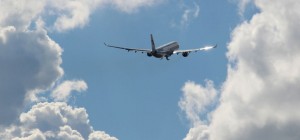

Published on : Thursday, May 12, 2016
 Investments made by airlines to improve the passenger experience by lowering fares, achieving better on-time arrivals and reducing the frequency of lost luggage1, along with enhancements to in-flight services and growing customer tolerance for extra fees have had positive effects on passenger satisfaction, says the J.D. Power 2016 North America Airline Satisfaction Study,SM released today.
Investments made by airlines to improve the passenger experience by lowering fares, achieving better on-time arrivals and reducing the frequency of lost luggage1, along with enhancements to in-flight services and growing customer tolerance for extra fees have had positive effects on passenger satisfaction, says the J.D. Power 2016 North America Airline Satisfaction Study,SM released today.
The study measures passenger satisfaction with North American airline carriers based on performance in seven factors (in order of importance): cost & fees; in-flight services; boarding/deplaning/baggage; flight crew; aircraft; check-in; and reservation. Satisfaction is calculated on a 1,000-point scale.
“While the perception of the airline experience still has a lot of room for improvement, there is notable progress in terms of satisfaction among the highest-ranked airlines in the study due to their keen focus on meeting or exceeding passenger needs. The airlines are clearly listening to their passengers and are taking action,” said Rick Garlick, global travel and hospitality practice lead at J.D. Power. “As a result, we see satisfaction rising across all touch points of the passenger experience.
Airlines are making positive strides by adding value to its products and services with newer and cleaner planes, better in-flight services, improving on-time arrivals and bumping fewer passengers from their flights. For airlines ranking below the study average, investing in product and service improvements now may reap big rewards in the future when it comes to retention, reputation and share of wallet.”
Following are some of the key findings of the 2016 study:
Customer Satisfaction Reaches 10-Year High: Overall satisfaction with the airline industry increases by a significant 9 points to 726, the highest score since the implementation of the current methodology in 2006. By segment, year-over-year passenger satisfaction with traditional carriers rises by a significant 12 points to 703 and with low-cost carriers by 9 points to 775. Airlines have made a concerted effort to improve the overall passenger experience by enhancing its product and service offerings.
Passengers More Tolerant of Costs and Fees: Satisfaction in the cost & fees factor continues to improve significantly, increasing by 12 points to 658 from 2015. While lower fares contribute to this improvement, passengers are also more tolerant of paying ancillary fees such as baggage fees or fees for extra legroom.
In-Flight Service‒The More the Better: In-flight services (650) remains the lowest-scoring factor overall in 2016, although it has improved significantly year over year (+12 points). In-flight entertainment, a core component of in-flight services, has been a particular target for improvement among several of the ranked airlines by adding more in-flight screens, more on-demand entertainment and also providing seat-side power plugs and Wi-Fi on board. Choosing an airline because of its entertainment options, customer service and Internet access all result in satisfaction scores of 800 or more.
Social Media Is the Feedback Tool of Choice: Seventeen percent of business travelers and 7% of leisure travelers post a comment about their airline experience on social media, with Millennials2 more likely to post comments than other generational groups. The most commonly used social media platforms are Facebook (77%) and Twitter (35%). While it may seem natural to expect the majority of social media comments to be negative, the vast majority of the comments posted on these sites are positive. When an airline responds to a social media post, there is an extremely large lift in passenger satisfaction.
Business Travelers More Satisfied Than Leisure Travelers: For the first time in the study’s history, satisfaction among business travelers exceeds that among leisure travelers by 8 points (733 vs. 725, respectively). Business travelers are considered premium customers to major airlines, as they travel more frequently, are less sensitive to price and are more satisfied with the cost/value of travel than are leisure travelers.
Study Rankings
Traditional Carrier Rankings
Alaska Airlines ranks highest in the traditional carrier segment for a ninth consecutive year, with an index score of 751. Alaska Airlines performs particularly well in all seven factors of the study. Delta Air Lines ranks second (725), improving in all seven factors.
Low-Cost Carrier Rankings
JetBlue Airways3 ranks highest in the low-cost carrier segment for an 11th consecutive year, with a score of 790 (down 11 points from 2015). This also marks the 12th consecutive year JetBlue has performed highest in the study. Despite ranking highest, JetBlue declines in six of the seven factors year over year, with aircraft being the only factor to improve slightly.
Southwest Airlines ranks second (789), improving in all seven factors year over year, most notably in aircraft (+15 points) and flight crew (+12).
The 2016 North America Airline Satisfaction Study measures passenger satisfaction among both business and leisure travelers of major carriers in North America. The study is based on responses from 10,348 passengers who flew on a major North American airline between March 2015 and March 2016. The study was fielded between April 2015 and March 2016.
Tags: j d power
|
||
   

|
||